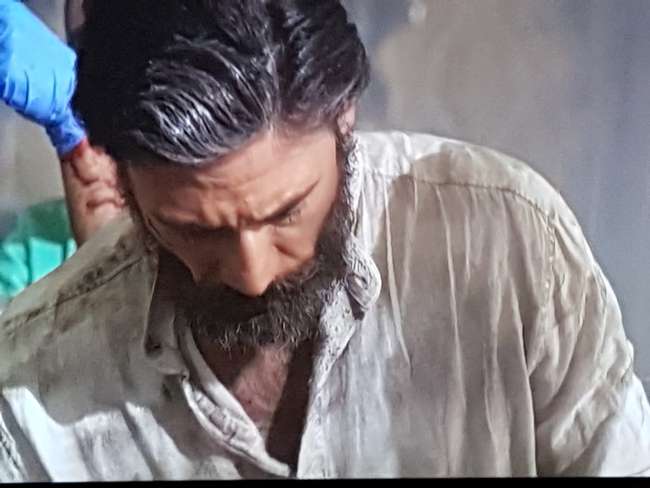Don Curry and the Temple Towers
Pubblicato: 03.02.2017
Iscriviti alla Newsletter
Don Curry can now summarize India in one word: colors. India is a country full of colors: whether it's spices, flower and vegetable markets, or the brightly colored saris of most Indian women, or the equally brightly painted temple towers of South India. All of these are bursting with colors of all kinds and shades. Don Curry wonders how the British, with their foggy nobility, could have endured these visual orgies, but perhaps evolution has left the northwestern European islanders with only the ability to distinguish distinguished shades of gray, while the ability to see colors has long become extinct due to centuries of non-use. In any case, Don Curry enjoys the colorful intoxication everywhere.
His accommodation, the Chettinadu Mansion, can itself be considered an example of uninhibited use of colors in India, just the combination of floor tiles, wall tiles and the bed cover on his bed would have driven a conservative interior designer crazy.
Unfortunately, he had to leave this lovely accommodation already, enjoyed the breakfast buffet one last time, and was driven north by Prince. A short stop was made at the picturesque fort of Tirumayam, which seems to be almost grown together with the giant boulders on which it was built.
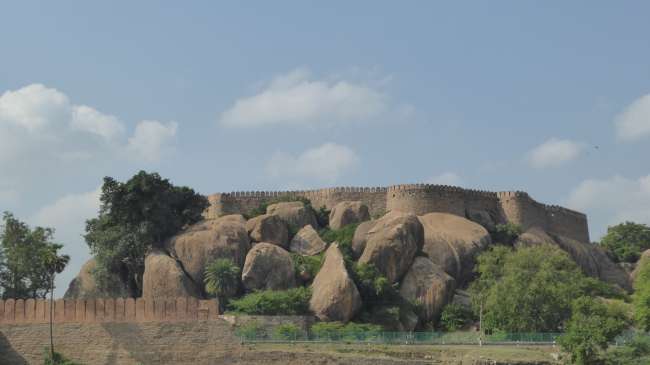
After passing through the metropolis of Tiruchirappalli, or Trichy for short, the river island Srirangam was reached. Here, Don Curry first visited the Arulmigu Jambukeswarar Temple, which may not be one of the most important temples in South India, but has been able to preserve a lot of originality precisely because of this. Here, for the first time, Don Curry had to leave his shoes simply on the street in front of the temple - no chappal and no self-proclaimed shoe guard in sight. But given his considerable shoe size, he could be sure that no Indian would accidentally slip into his footwear. In addition to the magnificent colorful temple towers, he was particularly fascinated by the floor mandalas drawn in the various corridors of the temple. This place was actually tourist-free and yet just as lavishly decorated and used by believers as the famous sanctuaries.
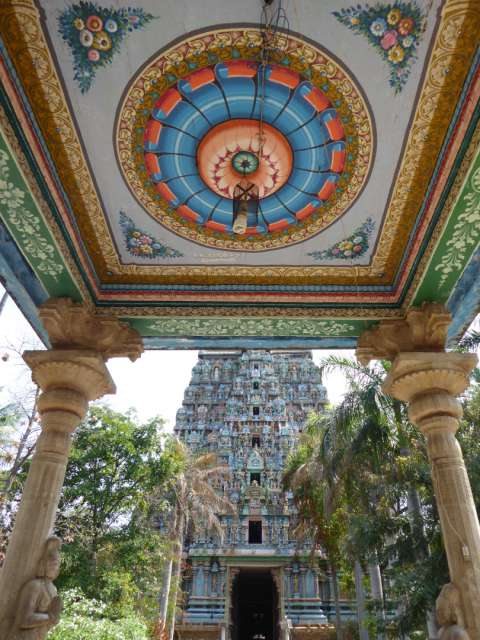
One of these famous sanctuaries in South India is the Sri Ranganathar Swamy Temple, which occupies a large area on the Srirangam island and is considered the most important Vishnu temple in Tamil Nadu. It also has the tallest temple tower in the world, which was only completed in 1987.
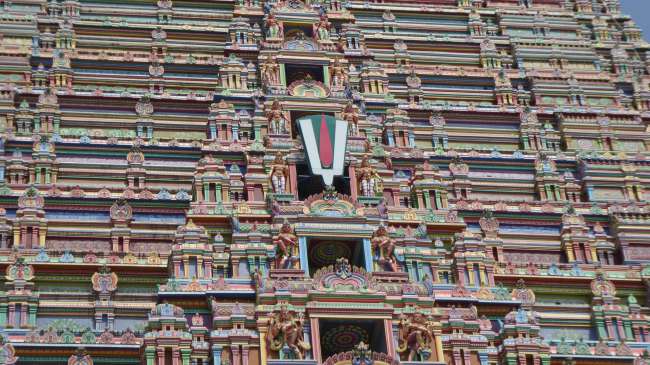
When entering the temple, there was the rare opportunity to climb an observation platform for a small entrance fee, which turned out to be simply the roof surface of various temple buildings. Due to hours of sunlight, this surface had already heated up so much that Don Curry could not stand still for a second without risking blisters on the soles of his feet. Thankfully, the best viewpoint was covered with the well-known synthetic mats; from this point, he could see not only all the colorful temple towers, but even the golden dome above the inner sanctum of the temple.
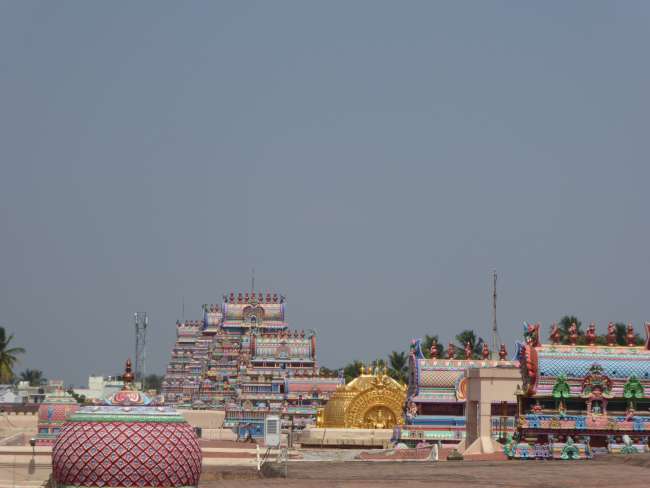
In contrast to the strong colors of the Meenakshi Temple in Madurai, pastel tones prevail here: from old rose to pale green to light blue. In addition to a total of 21 temple towers, Don Curry discovered a magnificent 100-pillar hall, whose outer columns depict life-size rearing horses and their warrior riders.
Until reaching the destination of the day, the ancient royal city of Thanjavur, only 62 km had to be covered. Prince knew a hotel restaurant here that he believed was also suitable for non-Indians; however, the restaurant mainly specialized in Chinese cuisine and therefore had almost exclusively Chinese customers. Nevertheless, Don Curry consistently chose Indian dishes, but had to wait significantly longer than usual for his order. Perhaps the - presumably Chinese - chef had to inquire how to prepare it?
After this lunch break, the area of the former royal palace was on the program. This rather confusing, extensive area in the northern part of the old town still has numerous historic buildings, which now serve as accommodations for various museums. First, Don Curry headed for the Maratha Darbar Hall, the former throne hall of the Maratha dynasty of Thanjavur from the 17th century. The pompous and lavish decoration on the columns, ceilings and walls still testifies to the splendor of a politically insignificant small kingdom in South India at that time. A British delegation would probably have been instantly blinded at the court of Thanjavur by this explosion of colors.
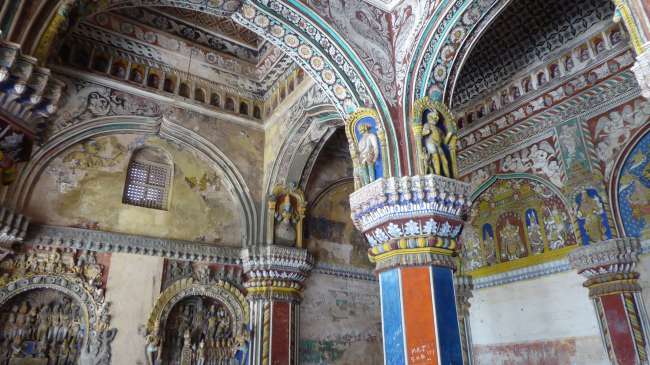
However, the cultural significance of Thanjavur is much more significant. A library that has been preserved to this day not only displays early prints, but also medieval palm leaf collections with texts of various kinds - an extremely rare treasure in tropical Asia with its climate of decomposition. The largest museum in the former palace is dedicated to the unique art of Thanjavur. The city is still known today primarily for bronze casting. Two extensive halls show powerful bronze statues, some of which go back to the 10th century, the time of the great Chola kings.
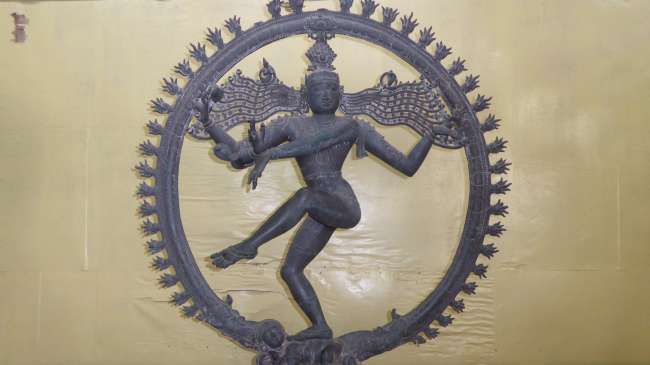
Exactly from this period comes the most significant attraction of Thanjavur: the Brihadisvara Temple, which was built by order of King Rajaraja I. This masterpiece of Dravidian architecture from the Indian Middle Ages was completed in just 6 years. At first glance, one can feel that this temple is part of the UNESCO World Heritage: while all the other temples visited so far - even the most famous ones - had small dirty corners in addition to all their beauty and splendor, this temple seems almost clinically clean. The outdoor area already welcomed visitors with beautiful, well-kept lawns and blooming shrubs. Information boards explain everything essential about the temple in multiple languages, and even the shoe deposit is not only signposted, but also relatively well organized; however, a rupee (approx. €0.015) per pair of shoes must be paid here.
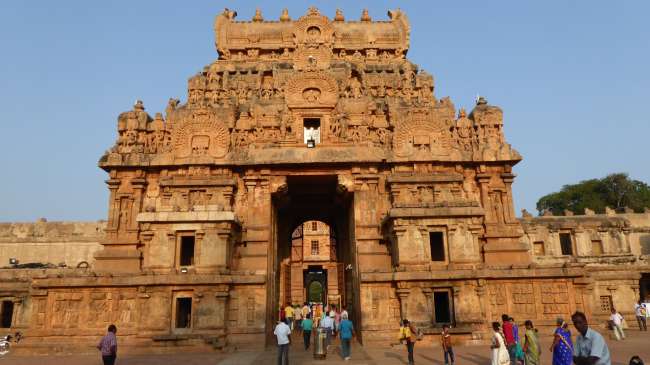
But even the temple itself makes a completely different impression than his previously visited South Indian colleagues. Instead of the mighty gopurams (tower gateways) that otherwise literally form the outstanding landmarks of the temples, here a powerful, pyramid-like tower above the inner sanctum overshadows everything. The colorful painting is also missing. The Brihadisvara Temple is completely dressed in the warm brown color of its gigantic granite stones, from which it was built, and all of which had to be transported from a distance of more than 70 km. In order to be able to place the 81-ton heavy dome, carved out of a huge granite block, on the tower, the builders had to construct a 6 km long stable ramp, on which the stone was probably brought into its final position with the help of elephants. Despite all this monumentality, the temple did not appear oppressive or intimidating to Don Curry, as its walls are decorated and divided with extremely detailed sculptures. In the light of the setting sun, the distinct shadows cast by the individual figures added another design element that reduced the temple's overwhelming impression. Many of the boundary passages also have delicate frescoes that do bring color into play. Don Curry was so impressed that he decided to visit this magnificent place again the next morning.
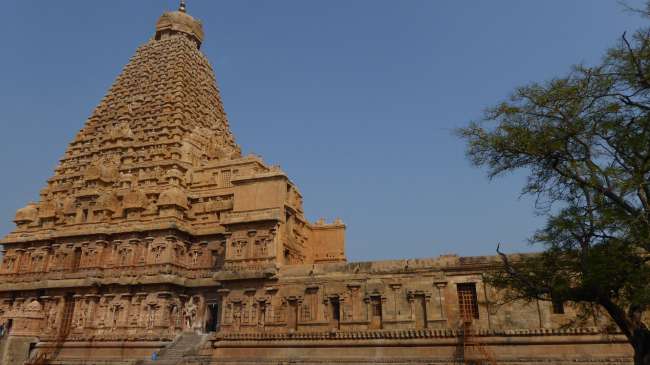
At the request of his driver Prince, however, Don Curry agreed to visit one of those special stores that presumably no one voluntarily enters, but that only get their customers through tour buses and tourist taxis. A bored porter always stands in front of the entrance, dutifully opening the door to the well-air-conditioned premises for the potential buyer. There is always enough sales staff on hand to handle whole busloads of tourists. Often, the lights are only turned on everywhere if an actual customer shows up; otherwise, energy is saved. All of these shops sell typical Indian handicrafts of the upscale category: ranging from tiny wooden elephants for €10 to life-size bronze Ganeshas for around €50,000. In order to get potential buyers delivered to these stores at all, they pay a small commission to the respective driver, regardless of an actual purchase, as Prince assured. Unfortunately, such a shopping spree is never relaxing, as one is treated politely and very accommodatingly, but always has to have at least a brief look at the entire range on all floors. Don Curry had done exactly that in Madurai, but here in Thanjavur, he wanted to shorten this big round: he actually had an interest in buying - namely THE icon of India itself, the Nataraja, which he wanted to buy as a small bronze figure here in the bronze casting city of Thanjavur. After about 30 minutes, he reached an acceptable price with a cup of masala tea and the usual negotiation methods and could make his travel bag even heavier. Prince was also satisfied: he had received his commission.
For today, all that remained was checking in at the Gnanam Hotel. Don Curry didn't really feel like having dinner at the restaurant. Therefore, he simply ordered a small meal and a large beer from room service. Shortly afterwards, the hotel employee served the beer and - free of charge - 4 large bowls of snacks: from salty popcorn to roasted onions and tiny peanuts to tapioca chips. At the next call, he brought the vegetable curry and a huge bowl of rice; at the third ring, he brought 2 paratha rotis and 4 different chutneys and raitas to go with the bread. Don Curry couldn't even finish half of this 'small meal', but he was once again amazed at how many colors this little private buffet brought to his room...
Iscriviti alla Newsletter
Risposta
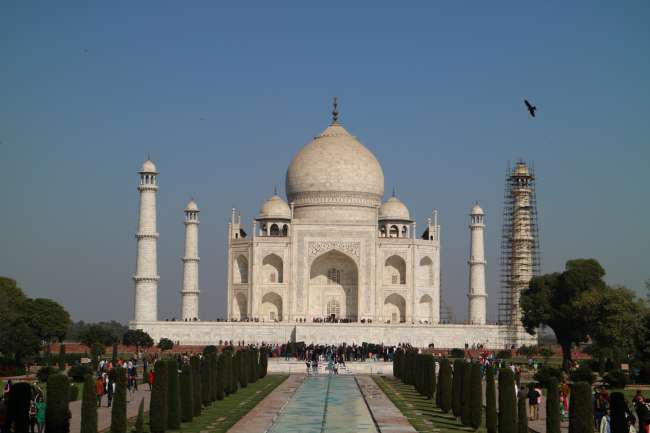
Rapporti di viaggio India

